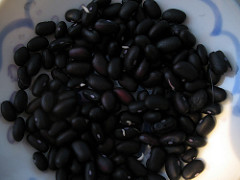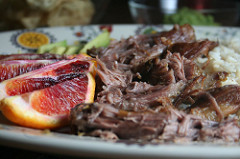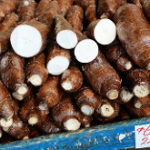
By Lisa Risager

By C.Levine

Dana Moors Plantains

Mennonite Board of Missions Photograph Collection. , Mission to Brazil.

Finger Lakes Community College, Costa Rica.
Christmas Feast
The smell of lip-smacking Lechon (roasted pork), filled the air each Christmas day in my family home. The smell of garlic and citrus juices together brings back a distinct memory for me. My mouth waters, when I smell it and my stomach growls till this day. The smell of sweet, slow roasted pork and the feeling of an empty stomach always helps to release my endorphins. This childhood reminiscence and tradition, my mother, bestowed upon my “American” family, will forever be embedded in my psyche. My mother’s father, had taught her, how to make this very special meal. The infamous meal in Cuba has the succulent Lechon, as its entrée with many side dishes to compliment it. Every Christmas in my house was celebrated as a “Cuban Christmas”. Conquistadores, are guilty for bringing the first pigs to Cuba. “Queen Isabella insisted that Christopher Columbus take eight pigs to Cuba in 1493” (Brand, 2016). Roasting a pig, is not only a Cuban tradition, but it is celebrated all around the world. “Pig roasting is a symbol of celebrations across the globe in many different countries. From Hawaii, to Puerto Rico, Cuba, the UK, and the Philippines and now in Other USA states and Canada pig roasts are a fun way to get people together (Admin, 2014). Roasted Pork- C. Levine
However, the Lechon (roasted pork) is consumed in many parts of the world, the sides that accompany the meal are Cuban style. The great meal consists of the Lechon (roasted pork), and the sides are: Fried platanos (fried plantains), black beans, white rice, yucca, Cuban bread, and mojo. Each side has its history of origin just as the pork does. I will give a brief history lesson of each side dish, whether they are indigenous to Cuba or not. I’ll begin with the plantain. The plantain is part of the banana family. They were brought to the island in the 1500’s. “The rapid expansion of the Bantu people of south and central Africa around 1500 A.D. is based largely on plantain trade. The plantains were traded to the Canary Islands, and from there they were introduced to Santo Domingo in the Caribbean by a Portuguese Franciscan monk around the year 1516 (Allen, 2016). I’m sure once they went to Santo Domingo, they eventually made their way to Cuba. Black Beans-Lisa Risager
Next, we have Cuban bread. I believed it was originally from the island and then brought to the United State by many Fidel exiles but, I assumed incorrectly.“The origins of “real” Cuban bread are debated, with both Miami and Tampa, Florida claiming to be the home of the best. With regards to where it originated, the earliest U.S. bakery to produce Cuban bread was most likely La Joven Francesca bakery,[1] which was established by the Sicilian-born Francisco Ferlita in 1896 in Ybor City, a thriving Cuban-Spanish-Italian community in Tampa” (Contributors, 2016). The bread is like the tortilla for Mexicans and Central Americans.
Third on my history lesson, are black beans which are a part of many Cuban dishes. “These beans date back at least 7,000 years, when they were a staple food in the diets of Central and South Americans” (Filippone, 2007).
Rice- Mennonite Church USA Archives (Archives)
Black beans and white rice need each other kind of like a marriage of food. Black beans separately (Moros y Christianos) or together which in Cuba is called Arroz Con’gri.
Fourth side is rice. Rice, is one of the first foods to be cultivated. “As far back as 2500 B.C. rice has been documented in the history books as a source of food and for tradition as well. Beginning in China and the surrounding areas, its cultivation spread throughout Sri Lanka, and India. It was then passed onto Greece and areas of the Mediterranean. Rice, spread throughout Southern Europe and to some of North Africa. From Europe rice was brought to the New World. From Portugal, it was brought into Brazil and from Spain to Central and South America” (Rost, 1997). Yucca- Modern Languages at Fingers Lakes Community College Costa Rica-2013
Cuba’s, dishes are an eclectic taste from countries, its distinct ancestry have shaped the current Cuban cuisine. “However, it was the Moors who, during their centuries of reign, most impacted Spanish gastronomy. Spain’s vast array of rice dishes, come straight from the Moors, as does the use of saffron, cinnamon, and nutmeg (Fernandez, 1989-2016). Yucca, is widely eaten with various dishes on the island. “The second major influence was Yucca, is the last side dish. African, arriving with the slaves that were brought to the island to undertake the hardest physical labor. From Africa came foods such as okra, taro root and plantains” (N/A, 2016).
Lastly, Mojo, which is an infusion of as many garlic cloves, as one can desire is fine, half a cup of olive oil or grade seed, 6 lemons bring all to a boil and there is your “Cuban Salsa”. Citrus is significant to give flavor to the meat and the mojo. “Citrus fruits were brought to America by the Spaniards (Columbus took seeds of citrus fruits with him in his second trip) and the Portuguese in their exploration trips to the New World, around year 1500. It is believed that the word “orange” originates from Sanskrit. International trade in fresh citrus fruits began almost two centuries ago. Even at its early stages, Spain played a dominant position in the Mediterranean area, supplying almost all citrus fruits shipped to United Kingdom, Germany, and France” (N/A, Citrus Fruits, 2007). The history lesson has been established, we must return to the recipe for the best meal can enjoy on Christmas.
According, to my mother we could only enjoy this meal twice a year on Christmas and Easter. On Christmas day, we were not allowed to eat until the feast was ready to be devoured. Her, theory was an empty stomach would allow you to eat all the roasted pig one could consume. If a person was to go walking through the streets of Cuba before (Christmas eve) or as it is known in Cuba Noche Buena, they would smell the streets engulfed with garlic, onions, citrus all infusing inside the Lechon. Traditionally, the meal began being prepared a day or two before. For the pig to be salty, sweet, tangy, juicy, and tender a process of patience and a bit of work would have to be put forth. Back in Cuba the pig endures a 12-hour process. The pig was roasted, with the same key ingredients we use today with the exception that it is placed underground and wrapped in banana leaves. However, in my house my mother only went out and bought the shoulder, which only required six to seven hours of slow roasting. As the days got closer to Christmas Eve or (Noche Buena) we would begin to prepare for our overly anticipated feast. I would go to the grocery store with my mother. She would advise me that only the best ingredients were to be bought for the meal. Our shopping hunt would begin heading straight for the meat section, her search was for the reddest, meatiest piece of 15-20-pound pork shoulder. After, she had acquired the best piece of pork in the store, we would beeline it over to the vegetable section. 1 pound of a bag of black beans, 1 pound of a bag of white rice1 bag of Garlic cloves, 15 limes, 15 lemons, 6 Oranges, 1 bottle of cumin, 4 white onions or red, 1 box of Goya sofrito (Cuban spice), 2 green bell peppers, a jar of bay leaves, 1 small jar of Spanish olives all of which filled the bottom of the basket. Yucca, black beans of any type are allowed, white rice, Cuban bread and olive oil were the next items to be put in the basket as side dishes which were to accompany the piglet.
Once home, my mom would instruct me on to how to begin preparations for marinating the pork. One needs to get a whole garlic break it, cut the ends off and peel it. Then get a whole onion and cut it up in tiny strips. A white, purple, or yellow onion will suffice. I like purple onions personally, to me they make they complement meats rather than the white or yellow. Those would be last they can be put in a bowl and put aside. Second step, 6 lemons, 6 oranges, 6 limes need to be cut in half. You can use a spoon to take out the juice of all the fruits. It is important that the pork is full of juice this helps the meat to break down more juice is better. The juice is going to fall to the bottom of the pan. Third, 1 table spoon of salt, 1 table spoon of cumin, 1 table spoon of sofrito is used to rub the pork down. Lastly, grab a sharp knife that has a pointy end. With the knife one must insert slits deep in the pork, this will allow the garlic cloves to sit tight inside while cooking. Get the garlic cloves and make sure that each side of the shank is entrenched with garlic. Place the shank in a deep roasting pan. Add the onion on top along with a bay leaf depending if you wish for an intense earthy flavor. Wrap it tight with aluminum foil leaving no possibility of air to seep out. During the roasting process its own moisture and juices will be absorbed. Allowing for the muscle to break down in the process. Put the pan in the refrigerator overnight. The pork is ready to be placed in the oven Christmas morning if you place it early a 15-pound shoulder, takes about six to seven hours.
Our next task, was to tackle the black beans the night before. There were only six of us eating the dinner, a pound of black beans was adequate. The black beans were to be washed, seethed through for any broken or bad beans. They were to be soaked throughout the night. The washing and soaking allows the beans to be cooked faster and allows all the gases to escape. The next morning, we would begin cooking the black beans while the pork roasted in the oven. We added 1 chopped bell pepper, 2 garlic cloves, 1 pack of sofrito, 1 bay leaf, a few Spanish olives, 1 chopped onion, and as much salt as our heart’s desired. The beans needed to be boiled 3 to 4 hours. The Yucca, needs to be peeled and cut to boil for 1 ½ hours until the starches begin to breakdown kind of like a potato. As time, would get closer to the pork being done. My mom would get 2 cups of rice and 4 cups of water to boil and then she would put it on a low heat allowing the water to evaporate any pan with a lid will suffice. Once, the beans, rice, yucca are done we would peel the plantains and fry them up in a ¾ sauce pan with olive oil. The bread could be served whole or cut into halves. The mojo was the last side to be made. Finally, take out the Lechon, serve your plate and enjoy!
Bibliography
Admin. (2014, March 18). Pig Roasting: A Walk Down Memory Lane. Retrieved from La Caja China: http://blog.lacajachina.com/pig-roasting/
Allen, J. (2016, December 13). History of Plantains. Retrieved from ehow Discover: http://www.ehow.com/about_5377146_history-plantains.html
Archives, M. C. (n.d.). Rice. 1954-1970. IV-10-7.2 Box 2 Folder 20, Photo #5. . Mennonite Board of Missions Photograph Collection. , Mission to Brazil.
Brand, O. H. (2016). The History of Pork. Retrieved from pork Be inspired: http://www.porkbeinspired.com/about-the-national-pork-board/the-history-of-pork/
Brent, M. (1999-2016). The Uses and History of the Yucca Plant. Retrieved from ehow Discover: http://www.ehow.com/how_8252033_prune-off-dead-flowering-stalk.html
C.Levine. (n.d.). Cuban Roasted Pork. N/A. N/A, February 22,2010.
Contributors, W. (2016, December 3). Cuban Bread. Retrieved from Wikipedia: https://en.wikipedia.org/w/index.php?title=Special:CiteThisPage&page=Cuban_bread&id=752771987
Fernandez, G. (1989-2016). Enforex Teaching Spanish since 1989. Retrieved from HIstory of Spanish Food : http://www.enforex.com/culture/history-spanish-food.html
Filippone, P. T. (2007). aboutfood. Retrieved from Black Bean History: http://homecooking.about.com/od/foodhistory/a/blkbeanshistory.htm
Moos, D. (n.d.). plaintain,yuca and sweet potato chips. N/A. N/A, October 24, 2009.
N/A. (2007, August 1). Citrus Fruits. Retrieved from orgin and History: https://citrusfruits.wordpress.com/2007/08/01/originhistory/
N/A. (2016). lahabana.com . Retrieved from Cuban Cuisine traditions and innovations: http://www.lahabana.com/content/cuban-cuisine-traditions-and-innovations/
Project, T. L. (n.d.). Yucca Root. Study Abroad Program, Costa Rica Spring 2013. Modern Languages at Finger Lakes Community College, Costa Rica.
Risager, L. (n.d.). N/A. Black Beans. N/A, July 21, 2009.
Rost, T. L. (1997). Rice Anatomy: Introduction. Retrieved from Division of Bilogical Science University of California, Davis: http://www-plb.ucdavis.edu/labs/rost/Rice/introduction/intro.html
